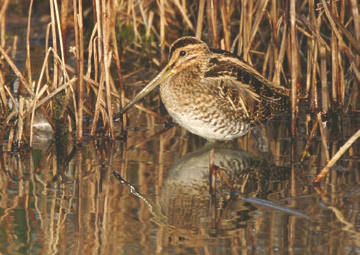
Snipe © Steve Round
Although most of the county’s farmland dries out too much to provide suitable breeding conditions for Snipes, it stays sufficiently wet during winter for Cheshire and Wirral to hold significant numbers of birds. They were recorded in 327 tetrads, almost half of the winter tetrads. They clearly avoid built-up areas, and were scarce in the higher land in the east of Cheshire. In the rural lowland parts of the county, many Atlas fieldworkers expressed surprise at how widespread they were, and how easy to find: any suitably damp area was likely to hold Snipe, well camouflaged but easily detected, if flushed, by their rasping ‘zip’ call and characteristic zigzag flight.
Snipes occupied a wide range of habitats. 39% of records came from farmland, most on improved or unimproved grassland, with 5% in flooded stubble fields. 33% were in freshwater habitats, mostly standing waterbodies (25%) of any size from pond or marl-pit to mere, with almost all of the rest on narrow ditches or streams. Semi-natural grassland or marsh accounted for 21% of habitat records (10% water-meadow/ grazing marsh, 6% reed swamp, 3% saltmarsh and 2% other open marsh) with 2% in bogs. They tend to rest by day and feed at night, eating more vegetable matter and seeds during winter, perhaps taken incidentally to their main diet of earthworms and tipulid larvae, with beetles, flies and their larval stages (BTO Winter Atlas).
They tend to form loose flocks when feeding or loafing. More than three quarters of records were accompanied by counts, showing that the median flock size was six birds. There were 16 counts of over 50 birds and four over 100, all in the last winter, 2006/ 07. The largest flock in the submitted Atlas records was near Statham (SJ68T), where David Bowman flushed an exceptional total of 166 birds on 20 December 2006, with other groups of 121 and 112 at Risley Moss (SJ69Q and SJ69R), and 104 at Aldford Brook Meadows (SJ45J). The wintering population of the county certainly exceeds 2,000 birds, and may be considerably more.
There is a substantial migratory movement of Snipe across Europe, with perhaps one million birds wintering in Britain and Ireland. Snipe from Iceland winter in the Western Isles and Ireland, and our wintering population comprises birds from Finland, Sweden and elsewhere in northern Europe as far east as Russia. Many of the Snipes breeding in Britain move south or depart for winter, to Ireland, France and northern Iberia, to be joined, during hard weather, by some immigrants that had started the winter in Britain (Migration Atlas).
The species’ winter status has probably not changed much in one hundred years. Coward (1910) wrote that ‘during the winter months the Snipe is generally distributed throughout the county, frequenting pit-sides and damp meadows, often singly or in couples, but sometimes in wisps of considerable size’. Boyd (1951) had notes of from fifty to one hundred or more during mild weather in each of the months November to February. He commented that ‘hard frost scatters them … many leave the district, and the few that remain pop up from any deep unfrozen ditch or spring which they rarely visit at other times’. Bell (1962) summarised the species as an ‘abundant winter visitor … birds found in all suitable localities during the winter’.
Sponsored by Syngenta CTL

